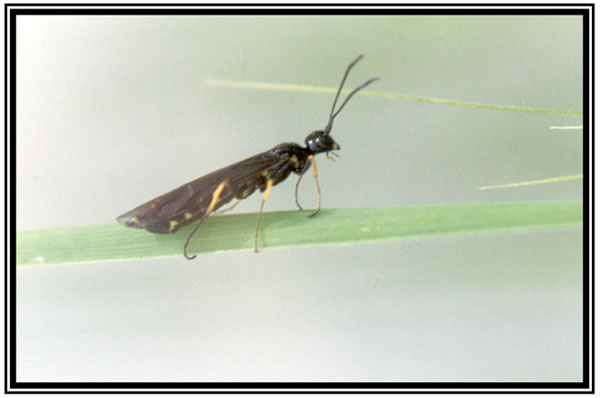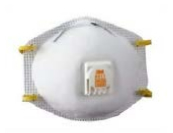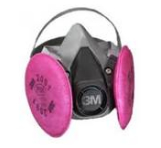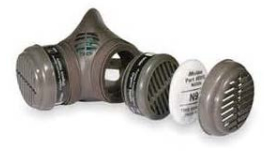MSU Pesticide News - May 2nd, 2015
Thimet 20-G for Wheat Stem Sawfly Control
Dr. Kevin Wanner, MSU Extension Specialist, Crop Entomology
Cecil Tharp, MSU Extension Pesticide Education Specialist

wheat stem sawfly (photo: Blodgett, S.L.)
The wheat stem sawfly (WSS) is one of the most damaging insect pests of wheat in the northern Great Plains region. The larvae feed internally within the stem, weakening the wheat stand that subsequently falls over prior to harvest (lodging damage). Foliar applied insecticides targeting the adult sawflies have not proven effective at preventing egg laying and subsequent damage by the larvae, due to the long 3-4 week emergence period of the adult insects. A systemic insecticide applied to seed at planting does not persist long enough within the developing wheat stems to kill the internally feeding larvae. However, a new application method for the insecticide Thimet 20-G® has received a 24 (C) special local need registration label for control of WSS in spring and winter wheat crops, and research has demonstrated that it is effective.
Thimet 20-G is formulated as a granular insecticide, with 20% phorate (the active ingredient) by weight. Phorate is an organophosphate class of insecticide, an older chemistry that is highly toxic to people and animals as a nerve toxin. Thimet 20-G is applied as a granular (5 lbs/acre) after wheat emergence and needs to be incorporated at least one inch deep between the crop rows, once per season. Thimet 20-G is a systemic insecticide, taken up by the roots and translocated up the wheat stem where it kills the WSS larvae. Applications must be completed before the WSS begins to fly and lay eggs, which in Montana can begin at the end of May or sometime during June depending on seasonal weather conditions. Efficacy is achieved by applying Thimet 20-G after the crop emerges, closer in time to when WSS larvae are feeding within the stem. Trials in Montana have demonstrated a 64- 100% reduction in damage measured as stem cutting by the larvae. Yield increases of 5.4 – 6.1 bushels per acre were achieved in spring wheat and winter wheat crops, respectively.
Equipment Considerations and Required Engineering Controls
- An air seeder with disk type openers is recommended to minimize damage to emerged wheat plants.
- Thimet 20-G® granules MUST be incorporated into the soil.
- This Lock’N Load product must be used with an enclosed loading system as defined by Worker Protection Standard (WPS) for Agricultural Pesticides [40 CFR 170.240(d)(4)].
- An adapter lid must be fitted to the air seeder for delivery of the insecticide granules into the fertilizer bin.
- Applicators must use an enclosed cab that meets the definition in the WPS for Agricultural Pesticides for dermal protection. In addition the applicator must wear long sleeve shirt, long pants, shoes plus socks while within the cab. The enclosed cab must also provide respiratory protection equivalent to a dust/mist filtering respirator or the applicator must wear a NIOSH approved respirator with any N, R, P, or HE filter (prefix TC-21C) while within the cab.
Safety & Environmental Considerations
Care should be taken when handling this product because it is a category 1 substance (DANGER- POISON). This product is extremely toxic to mammals (i.e. humans, dogs, cats, livestock) fish and birds. This product is fatal when swallowed, inhaled or absorbed through the skin and can cause irreversible eye damage on contact. Applicators must take the following precautions:
- Loaders, applicators and other handlers using proper engineering controls (including enclosed cab with dust/mist filtering capability) must wear long sleeve shirt, long pants and shoes plus socks. Loaders must also wear chemical-resistant gloves (any waterproof material).
- Applicators exiting the enclosed cab into treated area must wear: protective eyewear, coveralls, chemical-resistant gloves, chemical-resistant footwear and a NIOSH approved dust/mist filtering respirator with NIOSH approval number TC-21C with any N,R,P or HE filter. Applicators should remove PPE and store in a chemical resistant container before entering cab.
- When cleaning the Lock’N Load system or a spill, applicators must wear protective eyewear, coveralls, chemical-resistant gloves, chemical-resistant footwear and a NIOSH approved dust/mist filtering respirator with NIOSH approval number TC-21C with any N,R,P or HE filter. Applicators must have all PPE readily available even when not in use.
- Field reentry can be immediate if there will be no contact with the soil incorporated granules, otherwise the reentry interval is 72 hours.
The Product Label for Thimet 20-G® calls for a TC-84A Respirator
TC-84A respirators include:
#1 Filtering face-piece respirator (N, R, or P)

#2 Air Purifying Respirator (APR) with particulate filters (N, R or P)

#3 Air Purifying Respirator (APR) with combo chemical cartridge and filter (N, R or P filter)

Do not apply Thimet 20-G directly to an area where runoff is likely to occur. This product is highly toxic towards birds if exposed on soil surface or fish if product enters a body of water. Birds and mammals may be killed if granules are not properly covered with soil in all areas of treated field.
Applicators must delay harvest for at least 85 days after treating fields.
Further Information
Contact your county MSU Extension agent or for safety related questions contact Cecil Tharp (MSU Pesticide Education Specialist; 406-994-5067; [email protected]). For insect management related questions contact Dr. Kevin Wanner (MSU Cropland Entomologist; [email protected]). For more information on this product, lid adaptors for the Lock’N Load system or efficacy contact Tom Larsen, Amvac Chemical Corporation at 801-244-5050.
